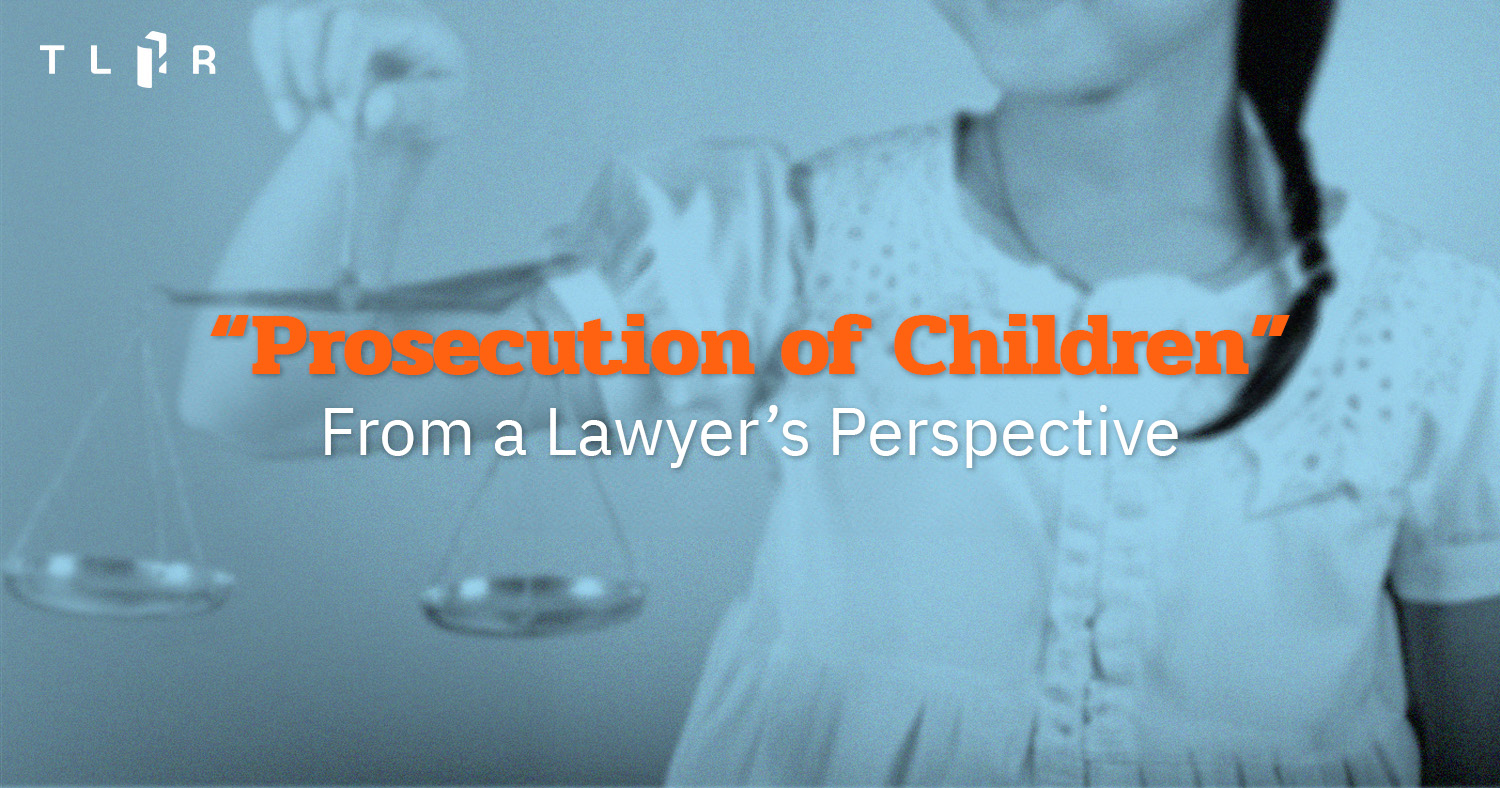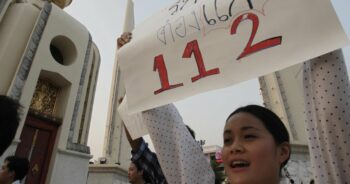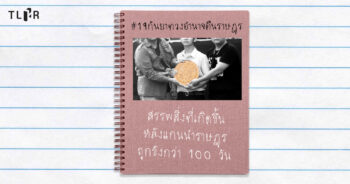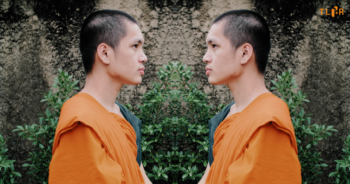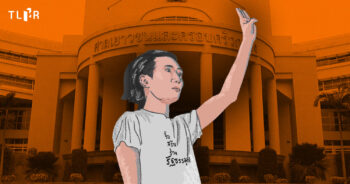(This article was first published in Thai on 20 September 2023. The statistics in this article have not been updated since then.)
In a cabinet resolution in 1985, the Thai government announced the celebration of “National Youth Day” every year on 20 September. As Thailand enters 2024 with a new government led by the Pheu Thai Party and celebrates National Children’s Day on 13 January, children and youth are still battling ongoing lawsuits, as they did last National Youth Day on 20 September 2023, in connection with their participation in political assemblies and expression in 2020 – 2023.
Since the first protest by the “Free Youth” group on 18 July 2020, at least 286 children and youth have been politically accused and prosecuted in 215 cases. Of the 215 cases, 73 have concluded, whereas 142 are ongoing at various stages. The youngest child facing political prosecution in Thailand to date is only 12 years old.
The charges used against these children and youth carry varying penalties ranging from fines under the Cleanliness Act, light imprisonment under the Emergency Decree, to a term of imprisonment as high as 15 years under Section 112 of the Penal Code (aka the lèse-majesté law).
Kumklao Songsomboon, one of the lawyers monitoring and representing children and youth in political lawsuits filed after 2020, shares some situation updates, her perspective on her work, lessons learned, and recommendations for an alternative criminal justice procedure based on youth’s thinking and beliefs in commemoration of National Youth Day on 20 September 2023.
The diversion of children and youth cases from the justice system: pre- and post-indictment measures and measures in lieu of a verdict serve as a push factor for confession.
The majority of cases against children and youth concern the violation of the Emergency Decree. In these cases, accused individuals tend to confess during the investigative or prosecutorial stage, and apply before indictment for “special measures” in lieu of a litigation under Section 86 of the Juvenile and Family Court and Procedure Act. Some cases carry a term of imprisonment longer than five years, such as those containing charges of lèse-majesté; possession of arms and explosives, and causing an explosion; or those involving victims, such as causing bodily harm against officers, setting fire to another person’s properties, and mischief. Whether the confession occurs at the investigative or prosecutorial stage, the lawsuit must be initiated first.
After the lawsuit has been initiated, children and youth can confess and either apply for post-indictment measures in lieu of prosecution under Section 90 of the Juvenile and Family Court and Procedure Act, or measure in lieu of a verdict under Section 132 of the Juvenile and Family Court and Procedure Act.
In addition to the fact that the child may have participated in the protest or committed the alleged offence or cannot afford a prolonged court process, children and youth’s likelihood to confess is often increased as a result of the government’s attempt to divert cases involving children away from the justice system through use of pre- and post-indictment measures and measures in lieu of a verdict. Since such an approach does not lead to a conviction, it has served as a push factor for children and youth, particularly the children’s guardians, who generally do not wish to see their child ending up in court due to fear of an undesirable outcome or possible criminal record.
Only a small portion of these children and youth have rejected these measures and decided to defend themselves in trials, including “Poom Hua Lamphong,” “Petch-Beem,” “Sainam,” “Eia,” “Mimi,” the “Bad Students,” activists joining the Talu Fah Village, activists participating in the car mob activity by the Feminist Liberation Group, as well as youths taking part in the activities by We Volunteer.

While representing children and youth in trials requires that you regard their wellbeing and future as primary considerations, you cannot simply abandon your fight to defend the rule of law or neglect the child’s will to exercise their right to freedom of expression and assembly.
In fact, in political cases against children and youth, regardless of whether the child has confessed or denied the charges, one important working principle is to put the child’s wellbeing and future, as well as their best interests, first. It is a basic legal principle.
The diversion of children and youth cases from the justice system is highly beneficial, especially when they have committed a criminal act that is an offence per se, e.g., causing bodily harms, murder, theft, etc.
However, in political cases in which children and youth are charged with violating the Emergency Decree, the diversion approach alone does not suffice because exercising one’s right to freedom of expression and peaceful assembly without arms is important to this group of children and youth. During the trial, it is thus crucial to also consider why the children have decided to join the protest and whether and to what extent the exercise of their freedom of assembly was constitutional.
For instance, Mimi was aware from the beginning of her case that if she confessed, she would be eligible for the pre-indictment diversion measure. However, she insisted on a defense in order to prove to the court that she was exercising her right to freedom of peaceful assembly without arms, that she was not the organizer of the protest, and that she had properly avoided activities that would lead to risk of disease transmission. The court acquitted her in the end.
Ear was clear since the first day of his arrest that he would take his case to trial to prove that he had no intention to join the protest – he just went there to receive a free meal but was too late to leave.
Prior to the witness examination in his trial, Sai Nam, who wore a crop top to a fashion show activity, had already known about the outcome of the case against “New Jatuporn,” who was accused of wearing clothes to mock the Queen in the same event and was convicted by the Bangkok South Criminal Court (New Jatuporn was sentenced to a three-year jail term, reduced to two years without suspension). However, Sai Nam insisted that he had no intention to mock or ridicule King Rama X, and that he simply imitated “Justin Bieber,” a famous singer, in the fashion show activity.
During Sai Nam’s trial, I admit that there was a valid concern that the court decision in New Jatuporn’s case might affect Sai Nam’s with the two cases being so similar in nature. Nevertheless, as a lawyer, in addition to proving the fact, I must reiterate the legal principle that mocking or ridiculing another person is not considered an insult under Section 112 of the Penal Code (lèse-majesté). The cases against the two will be subject to further deliberation by the Appeals Court.
Another mockery case involves Petch and Beam, two youths who wore crop tops at Siam Paragon. The case is currently in the witness hearing stage, and the result remains uncertain.
While the prosecution of those who participated in the 2020–2021 protests and the outcomes of the lèse-majesté cases have had some effects on the exercise of the rights to freedom of assembly and expression as a whole, I believe that we will still most definitely see children and youth in new waves of protests.
In my opinion, the prosecution of thousands of protesters of 2022-2021 protests has had a particular effect on protests led by the group of youth who tended to respond with force to the dispersal of protests by the police, such using pebbles, slingshots, marbles, firecrackers, fireworks, ping pong bombs, etc.
In lèse-majesté cases, such as cases in which the defendants wore Thai dresses, crop tops, and GuKult stickers; said “Very brave, very good, thank you;” or had a large social media following, such as Mum Dew or Warunee, I believe the outcomes have made children and youth more careful about what they say, write, or communicate, so that it won’t be used against them by the State or opposite groups in a lawsuit.
However, in general, these outcomes are not enough to deter children and youth from coming out and expressing their opinions widely on all social media platforms.
Frankly, we must come to terms with the reality that children and youth today are politically aware; they have information and knowledge in their hands and realize that politics is not as irrelevant as adults had made them believe. What kind of education policies do the political parties in the next government have? Will they abolish the mandatory haircut or uniform? These are only some of the examples of what is directly related to them. The high political alertness coupled with the creativity and self-confidence inherent to their age mean that the children and youth have a major role to play in the country’s politics.

Lessons learned from the 2020-2021 mass protests reflect the failure of the justice system to regard the wellbeing and future of children and youth, as well as their “best interests,” a primary consideration.
During arrests of children, we have found that police have used force and have not provided immediate medical attention in case of injuries. Children and youth have had their mobile phones seized and were not allowed to contact their lawyer or parents. In several cases, the children had been brought to the inquiry officers, and it was only after they had confessed and signed all the documents without reading them that the child’s lawyer and parents could locate them.
When we went to the Juvenile Court to request the court to examine the arrests, the court issued orders confirming that the arrests had been lawful, as is typical. This was despite the fact that we already stated the reasons verbally and submitted written objections against ‘an unlawful arrest’ – defined by the Juvenile and Family Court and Procedure Act as one where force is used, and the arrestee is not allowed to contact their relatives or lawyer. The judicial review serves as an important step that enables the court to scrutinize whether the police complied with the law in order to protect children and youth’s wellbeing.
At the public prosecutor’ stage, we found that public prosecutors have decided to drop some Emergency Decree cases against adults, but indict almost all cases against children and youth, given they had refused to confess. I have written letters asking for their favor to not process many cases involving children on the grounds that it does not serve public interests and it is not in the sake of children and youth’s wellbeing, future, and best interests. Yet, the public prosecutors claimed that the law prevents them from doing so and requires that children be prosecuted if they violate the law.
Ear, a 12-year-old child who rode a bicycle to a demonstration to receive a free meal, was accused of “joining a protest deemed risky of disease transmission and violating the curfew.” We spent over two years with the case in the justice system, arguing that although Ear was guilty, he should not be punished, but should receive a warning instead. How would society benefit from Ear’s conviction? On the contrary, it would have caused traumas to him and his family because nobody in is family wanted to believe that one food box could change a child’s life forever.
At the court’s level, almost all court judgments in protest cases have failed to guarantee the right freedom of assembly according to the Thai Constitution and the Convention on the Rights of Child. Acquittals only occurred about when there was a lack of evidence to prove that the defendants were the organizers or participants in an assembly deemed risky of disease transmission.
As for the lèse-majesté cases, the provision carries too high an imprisonment term, comparable to the offence of involuntary manslaughter. Even more problematic is its enforcement, as the overbroad interpretation means that the law applies to diverse types of acts and is linked to customs and tradition, making it difficult for children and youth to know exactly what acts are considered an offence. This goes directly against the principle of strict and narrow interpretation of the law. More importantly, anybody can file a case.
As a lawyer who works on political and lèse-majesté cases, the saying “There is nothing to worry about if you’re not guilty” only applies to general criminal cases, not lèse-majesté cases. If you follow the cases taken up by Thai Lawyers for Human Rights, you’ll see that while many of them filed by members of opposite groups or royalist groups are based on actual acts, they do not fall within the scope of the crime. These include referring to a former king or persons outside of the protection of the law, wearing clothes regarded as mockery or ridicule, affixing stickers of the king portrait, etc.
As it has turned out, the law has been instrumentalized by groups of opposite political stances. Whenever the other groups express opinions or criticism, no matter if they address a public concern or quote publicly available academic sources, the said groups often respond by filing an allegation first. Whether the accused is guilty or not is up to them to prove to the court.
Then, there is the mobilization of individuals bringing accusations in regions other than one in which the target resides. For instance, the defendant lives in Bangkok, but the case has been brought in the south, and vice versa; or the defendant is in the Northeast but the case has been filed in the North. Can anyone not see the true intention of these operations? In particular, if the accused are children or youth, they are at risk of having their futures ruined and carrying a criminal record forever. Most importantly, they will lose faith in the law and justice system, which will impact society in the future.
In the lawsuits arising from protests, children and youth who decide to confess and accept the pre-indictment measures must comply with the rehabilitation plan determined by the director of the Juvenile Detention Center. If the child manages, the case is abated. Should they have accepted the post-indictment measures or measures in lieu of a verdict, they must comply with the rehabilitation plan determined by the director of the Juvenile Detention Center or the person authorized by the court. If the child manages, the court disposes of the case. In some instances, courts have passed a suspended imprisonment sentence and determined probation conditions.
Lèse-majesté cases against children have unfolded in different ways: where the defendants confessed and accepted measures in lieu of a verdict under Section 132 paragraph 1; where the defendants defended themselves in a trial and were sentenced to a suspended imprisonment (such as in the case against Sai Nam, a young person who wore a crop top in a fashion show); or where the sentence of imprisonment was converted to a training at the Training Center (such in the case against “Petch” who gave a speech at King Taksin the Great Monument). Despite the name, the “Training Center” is de factor a place of confinement.

| “The Training Center” is defined by Section 4 of the Juvenile and Family Court and Procedure Act as an agency or an organization established under the Juvenile and Family Court Establishment Act with tasks to control, look after, rectify, rehabilitate, improve behaviors and habits of, provide general or vocational education for, and help and support children and youth. A child in conflict with the law may be required to attend training at such a Training Center after the Juvenile and Family Court has issued a verdict. The Center shall also prepare the children and youth for problems in the outside environment and monitor them as they return to their family and society, as well as coordinate with the community to prevent a repetition of such crimes committed by children and youth in the future. The Regulations of the Department of Juvenile Observation and Protection on the Operation of Shelters and Training Centers B.E. 2547 (1964) establishes some principles related to the Training Center, including: 7. The supervising facility shall require that children and youth go up to the sleep quarter at 5.30 PM and come down at 6 AM. This can be adjusted as appropriate. 8. The Director of the Juvenile Detention Center and the Director of the Training Center shall provide for security personnel to provide protection to children and youth at all times throughout the period during which they stay at the supervising facility. 11. In the event of moving or transferring children and youth to attend an activity, officials shall do a head count and submit it as proof and shall not allow children to be absent from the said activity. 32. The operations of the shelter shall be enforced mutatis mutandis, for example, with regards to prohibited items brought into the shelter, such as cash, all kinds of communication devices, obscene publication or media, and all kinds of medication unless prescribed by physician. 25. After three months, if, within the month, children and youth have not committed an unlawful act, a sinful conduct, or a disciplinary offence that led to any form of punishment, they shall be entitled to a home leave. |

Recommendations with regards to children and youth’s exercise of freedom of expression and assembly in politics.
To officials in the child justice system and society at large, we must not forget that we are already in the 21st century. The children and youth in our country are not only Thai citizens, but citizens of the world. The interconnectedness and transport across countries of technological information has allowed children better access to information and knowledge across the globe. This also encompasses different ideas and cultures, such as human rights, the rights to freedom of expression based on democratic principles, the respect in human dignity, the belief that “everyone is equal,” and the rejection of “authoritarianism.” These are all mainstream global ideas and expressing them is not a crime.
The problem is Thailand has certain legislations that are not in line with the said principles. Moreover, the enforcement of laws is still dominated by the traditional and customary mindset or perspective that “children have the duty to study” or “politics is not for children.” This has led to a clash between two ideas.
As children and youth enter the justice system, an area under the authority of law enforcement, officials need to listen to children and youth and try to understand the ideas that motivate them. They need to work to filter out cases and interpret the law in a way that protects the rights of children and youth.
I would like to propose ways that Juvenile Detention Centers and courts should develop the child rehabilitation plan or probation conditions, as both bad and good practices have been identified.
As for the bad practices, arranging a training in a military barrack, for instance, made children feel unsafe, as they had been accused of protesting against the prime minister, who was a former military general and involved in the coup. Forcing children to prostrate at their parents’ feet in front of a large group of people made children feel awkward due to existing family issues. Forcing children to handwrite their dream job felt like a punishment because they did not see how that would inspire them to really pursue that career. Instead of requiring children to take and send a picture of themselves prostrating and worshiping a portrait, children felt that there were many other more reasonable ways to pay respect. Instead of prostrating, it would have been better to perform a community service, for example. The list goes on. During meetings in the development of the rehabilitation plan, I have had the chance to raise these issues to officials, some of which have been addressed.
The best practices I would like to encourage in the development of a rehabilitation plan include allowing children to perform community service in the format or with an organization of their choice; decide on the vocational training they are interested in; use their creativity and confidence to express themselves, such as being a Tiktoker; or attend a class on how to earn a living online, etc.
The question is, how can we make the child criminal procedure as child-friendly as possible?
